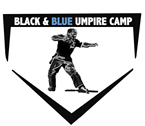| Home |
| Ball Stays in Infield |
| Fly Ball to Outfield |
| Batted Ball to Outfield |
| Everything Else |
| PreGame Guide |
| Study Guide |
| Resources and Links |
Site Maintained by: DataBase Management Services |
| Introduction | Fly ball coverage for 3-umpire mechanics is simplified in the following manner:
NOTE: When base umpires are at their bases on the line they are known as a "wing" umpire or being on the "wing". Using this "Basics of Baseball Three Umpire Mechanics" the wing umpire will go out to cover a fly ball when the ball is hit in his coverage area for these reasons:
|
|---|---|
| Keys To Covering Fly Balls |
PAUSE: That is don't move from your position and watch where the ball is going. React only with your head and eyes, and maybe turning your body, by watching the initial flight of the ball, then...
READ: Pick up the area were the ball is going by watching the fielders' reactions, then... REACT:
|
| Bases Empty |
Positions:
Coverage and Movement of the Umpires:
1st Base Umpire:
3rd Base Umpire:
Plate Umpire:
Example
Bases empty - Fly ball to right field - 1st base umpire goes out to cover fly ball. Plate umpire moves up the 1st base line and takes the batter-runner touching 1st base. If it is not a catch the plate umpire would be responsible for plays back at 1st base. |
| Runner at 3rd Base Only | Positions:
Coverage and Movement of the Umpires:
1st Base Umpire:
3rd base umpire DOES NOT have tag up responsibility in this situation. Instead the 3rd base umpire will head directly towards 1st base and cover any plays at 1st and/or 3rd if the runner does not tag up. 3rd Base Umpire:
1st base umpire will run towards the working area and cover the batter-runner touching first and be ready for plays at the bases including 3rd base if the runner at 3rd does not tag up. With less than two outs the 1st base umpire will also cover the runner at 3rd if he does not tag up. Plate Umpire:
|
| Any Time Runner is at 1st Base |
Positions:
Coverage and Movement of the Umpires:
1st Base Umpire:
If the 1st base umpire goes out to cover the fly ball the 3rd base umpire and plate umpire will revert to the two-umpire system. 3rd base umpire will move to cover tag up at first and any throw backs at first. If the ball is dropped coverage is the same as the two-umpire system. 3rd Base Umpire:
Plate Umpire:
Examples
Fly ball coverage in 1st Base Umpire's area:
|
| 1st Base Empty and a Runner at 2nd Base (Runner at 2nd Base only or Runners at 2nd and 3rd Base): | Positions:
Coverage and Movement of the Umpires:
1st Base Umpire:
The 3rd base umpire will move to a position outside the diamond near third base watching tag up and action at third. If the ball is not caught coverage will be just like a batted ball that gets through the infield situations. 3rd Base Umpire:
If the fly bal is hit in the 1st base umpire's coverage area DO NOT get happy feet and move into the diamond. STAY on the outside of the diamond near 3rd base and be ready for any plays at third including touches of 3rd base by runners. Plate Umpire:
Example
Fly ball coverage in 1st base umpire's area when he is inside the diamond. |
